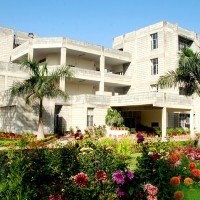Guru Nanak Public School in Chandigarh, Punjab Admission, Fees Structure

Where is Guru Nanak Public School ?
Guru Nanak Public School is Located in Chandigarh , Punjab, India
Address of Guru Nanak Public School, Chandigarh
Sector 36-D (Senior Wing),
Sector 37-B (Junior Wing),
Chandigarh Punjab
+91-1722601214 ,
+91-172-2605019,
+91-172-2696293
gnpschandigarh@hotmail.com
How do I contact Guru Nanak Public School?
Call at +91-1722601214 to contact Guru Nanak Public School
About Guru Nanak Public School
Many things we need can wait. But the child cannot. Now is the time his bones are being formed, his blood is being made and his senses are being developed. To him, we cannot answer tomorrow. His name is today "
- Gabriela Mistral.
Children are endowed with a keen sense of perception to observe everything around them in the contemporary, dynamic society. Guru Nanak Public School is the ground that sows the seeds of rationalization and maturity. It is an institution where the expectations and dreams of students are fulfilled, where the creative minds meet professional faculty, where learning is a life-time experience!! In short, where buds blossom into flowers!The portals of GNPS lead you to a mellow red brick edifice impressing the entrant. It encompasses a miniature world where lessons of discipline and hard work - the signposts of success are taught. The school's amazing journey started with its inception in the year 1974. The school building was formally inaugurated in February, 1976 by Giani Zail Singh - the then Chief Minister of Punjab. The school has state of the art infrastructure, spread over 16 acres. The school as it stands today, strategically in the heart of the City Beautiful, amidst the beautiful ambience of lush green lawns and sprawling play grounds, is ably managed by honorary stalwarts, bureaucrats constituting the Governing Council . The pristine clean building houses all smart class rooms in Junior Wing as well as in Senior Wing, 4 Science Labs, two 3D Labs, digital Maths and English Lab, Digital Library with more than 20,000 books, 4 I.T. Labs, a Medicare Unit with a full time Doctor, Boys and Girls Hostel, 4 big activity halls, open air theatre, lush green grounds and sports facilities.The English medium ,co-educational, CBSE affiliated ,Senior Secondary School has top notch 100% Board results of Class-X as well as Class-XII to its credit. With emphasis on holistic development of children, GNPS students are global citizens with habits and thought process to build a better India and the World. They are highly ambitious and do very well once they pass out of the school. The students show very strong leadership qualities and possess excellent communication skills. Majority of the students remain connected with the school and that is reflected by the strong Alumni Assocation of GNPS - ‘Seguns‘.Apart from the academics, sports and co-curricular activities, due emphasis is laid on character building ,life skills , personality development and value education. It has a universal approach towards all religions. The love for mankind, humanity, feelings of universal brotherhood and other moral values are an integral part of the education. Children regain the freedom to jump and play, and that freedom and environment is provided by Guru Nanak Public School where activity based learning is emphasized in place of examination oriented one. The school organizes many co-curricular activities - moral, sports, literary, cultural and religious; trips and excursions, etc along with academics so as to give maximum exposure to the kids and for development of their all round personality. Initiative, daring and enterprising outlook is developed in every student.
The master plan of the city was prepared by Swiss-French architect Le Corbusier, which transformed from earlier plans created by the Polish architect Maciej Nowicki and the American planner Albert Mayer Most of the government buildings and housing in the city were designed by the Chandigarh Capital Project Team headed by Le Corbusier, Jane Drew and Maxwell Fry In 2015, an article published by BBC named Chandigarh as one of the few master-planned cities in the world to have succeeded in terms of combining monumental architecture, cultural growth, and modernisationChandigarh's Capitol Complex was in July 2016 declared by UNESCO as World Heritage at the 40th session of World Heritage Conference held in Istanbul UNESCO inscription was under "The Architectural Work of Le Corbusier an outstanding contribution to the Modern Movement".
The Capitol Complex buildings include the Punjab and Haryana High Court, Punjab and Haryana Secretariat and Punjab and Haryana Assembly along with monuments Open hand, Martyrs Memorial, Geometric Hill and Tower of Shadow and the Rock Garden The city has one of the highest per capita incomes in the country The city is the cleanest in India based on a national government study The union territory also heads the list of Indian states and territories according to the Human Development Index In 2015, a survey by LG Electronics ranked it as the happiest city in India over the happiness index.
The metropolitan area of Chandigarh, Mohali and Panchkula collectively forms a Tricity, with a combined population of over 1,611,770
It bordered the Balochistan and Khyber-Pakhtunkhwa regions to the west, Kashmir to the north, the Hindi Belt to the east, and Rajasthan and Sindh to the south The people of the Punjab today are called Punjabis, and their primary language is Punjabi The main religion of the Pakistani Punjab region is Islam The two main religions of the Indian Punjab region are Sikhism and Hinduism Other religious groups are Christianity, Jainism, Zoroastrianism, Buddhism, and Ravidassia.
The Punjab region was the cradle for the Indus Valley Civilisation The region had numerous migration by the Indo-Aryan peoples The land was later contested by the Persians, Indo-Greeks, Indo-Scythians, Kushans, Macedonians, Ghaznavids, Turkic, Mongols, Timurids, Mughals, Marathas, Arabs, Pashtuns, British and other peoples Historic foreign invasions mainly targeted the most productive central region of the Punjab known as the Majha region, which is also the bedrock of Punjabi culture and traditions The Punjab region is often referred to as the breadbasket in both India and Pakistan.